The 10 most absurd parts of a Duke-UNC overtime thriller for the ages

The most despised program in college basketball was down 13 to its archrival with four minutes remaining. It was also down its best player. Its win probability had dipped to around 2%. This was not the first seemingly unsurmountable deficit Duke faced at North Carolina on Saturday night. Remarkably, it would not be the last.
But over the next hour, exactly eight years after one of the most memorable buzzer-beaters in Duke-Carolina history, a dull college basketball season exploded into life. A previously mundane game became an instant classic. The Blue Devils beat two buzzers and twice resuscitated themselves when live odds told them, Don’t even bother trying.
WHAT. Duke wins it at the buzzer in OT. pic.twitter.com/DJTIHK3u8I
— Kyle Boone (@Kyle__Boone) February 9, 2020
The probability of overcoming all those odds – the 13 points with four minutes left, the nine points with two minutes, the five with less than 20 seconds remaining in OT, and so on – is some minuscule number that even brainiac Duke students would struggle to comprehend.
Yet there is no number, no amount of decimal places, no graph that can explain how preposterous Season 101, Volume 1 of the sport’s greatest rivalry truly was. And certainly no final score – Duke 98, UNC 96 (OT) – that can do it justice.
So let’s rewind. Perhaps a reliving of the madness can. Here, in mostly-chronological order, are the most absurd aspects of an absolutely ridiculous Duke win.
Carolina’s mismanagement
Saturday’s game was one Duke had no business losing and no right to win. Which makes zero sense. Which is as much sense as these 45 minutes of basketball made.
Carolina came in at 10-12. Duke was 19-3 and ranked 7th nationally. The first shocker of the night was that the Tar Heels held a lead that bounced in and out of double digits for much of the second half.
Their management of that lead, however, kept Duke alive. For example, with a 12-point advantage and around eight minutes to play, on three straight possessions: 1. Cole Anthony tossed up a wild, contested runner early in the shot clock. 2. Christian Keeling forced a pass in secondary transition; it got stolen. 3. Justin Pierce took an awkward turnaround jumper from the post.
Later, up nine with under two minutes remaining – and with a win probability nearing 98% – Anthony raced past a double-team, encountered a third Duke defender, and ... tried to bank in a 12-foot floater with the shot clock showing 20. It rimmed out, and seconds later, Alex O’Connell – who’d made one 3-pointer in his previous seven games – drilled his second triple of the night to cut the lead to six.
Yet in a few key spots, awful possessions yielded layups:
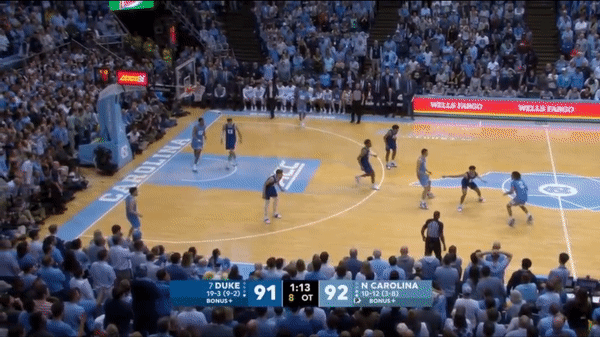
So much else had to go wrong for the game, from a UNC perspective, to go awry.
Carolina’s missed free throws
North Carolina was 21-38 from the free throw line. Twenty-one for thirty-eight. That’s 55.3%. That’s 17 misses. And it’s dreadful. Here’s a compilation of 11 of the 17 – all from the second half and OT:
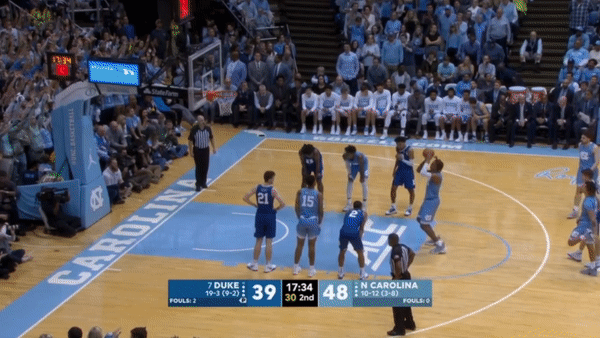
And yet UNC still had a four-point lead with 22 seconds left in regulation.
Duke let golden opportunities slip
A quick Tre Jones layup halved that lead. Then Anthony, with 13 seconds remaining, tried to split a double and turned the ball over!
Duke essentially had a 3-on-1 to tie the game or take the lead for the first time since the 18:32 mark of the first half ... but Cassius Stanley mishandled a pass, and Garrison Brooks denied him with the game seemingly on the line!

In the moment, that seemed like Duke’s one and only chance. And it seemed like it had evaporated.
Tre Jones’ epic free throw miss
But Andrew Platek missed one of two free throws. Carolina fouled up three. And by now you know the rest. It was the right decision. It produced an unforgettably wrong outcome:
Tre Jones has ice in his veins and sends Duke/UNC to OT!
(via @jackfrank_jjf) pic.twitter.com/8uMXzrjqnE— Yahoo Sports (@YahooSports) February 9, 2020
Breaking down buzzer-beater No. 1
There are so many brilliant, crazy, underdiscussed details of Jones’ intentional miss. Let’s jump around to a few of them:
Before the second free throw, Mike Krzyzewski substituted in three of his best rebounders. This, naturally, drew Carolina’s focus to the paint. Even Anthony, the one Tar Heel not lined up on the lane, sprinted toward the rim right when Jones chucked the ball at it.
Jones’ miss, however, was far more calculated than you realize. “Me and [assistant coach Jon] Scheyer have talked about that exact moment,” Jones explained to ESPN’s Holly Rowe after the game. “He told me it’s probably best to take a couple steps to the right so it ricochets.” Sure enough, look at Jones’ positioning on the line:
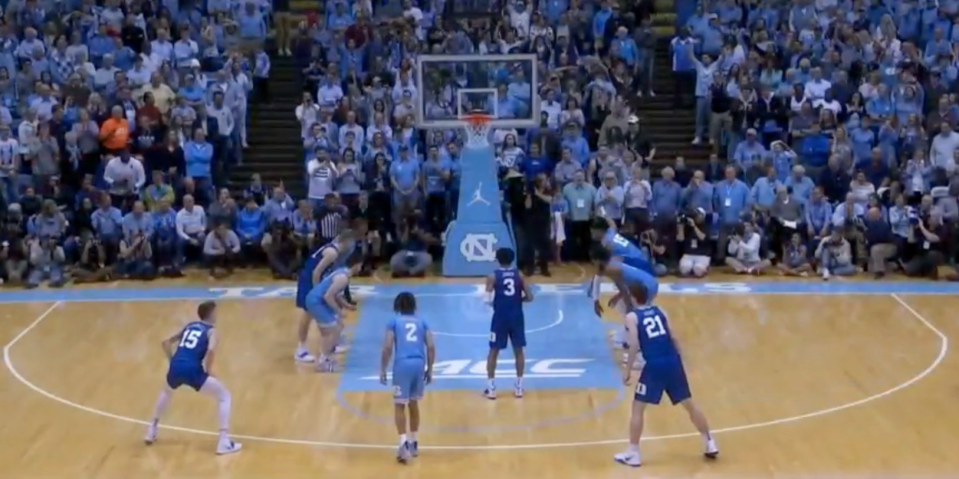
“And in practicing it,” Jones continued, “I feel like it comes off the same spot every time.” So while Anthony charged in toward the free throw line, Jones anticipated the bounce and somehow caught the long rebound on the fly!
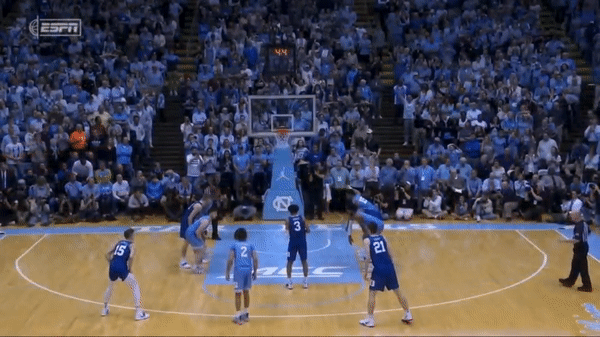
Jones took 25 shots on Saturday. He took nine from 15 feet away or farther. That was the only one of the nine that he made.
Judging by the way they sprinted onto the court to mob Jones, some Duke players definitely thought they’d won the game right then and there. Which could have accentuated the embarrassment of an overtime loss. Instead, they got to do it all over again a half hour later.
Carolina was running out of bodies
Early in the overtime period, Duke went up 5, and had Carolina +7.5 bettors trembling in fear of an unfathomably bad beat. It didn’t help that the Tar Heels were running out of bodies. Roy Williams had been rolling with a seven-man rotation. At the end of regulation, Christian Keeling went to the locker room, and seven became six. Then Brooks got poked in the eye, and six became five. Then Leaky Black fouled out, and ...
The UNC staff started frantically looking and motioning toward the tunnel. As Brooks headed back to the locker room, Keeling came running out of it ... and straight to the scorer’s table to check into the game!

Then, with 3:15 left in OT, Armando Bacot fouled out. So Williams went to Walker Miller, brother of former UNC walk-on-turned-starter Wes, a junior whose 2020 stat line to date was 5 minutes and 0 points.
Miller’s trip to the free throw line summed up the absurdity of the evening. Here was the eighth man in a rotation that went seven-deep, wearing what looked like a practice jersey, with the biggest regular-season game in college basketball at his fingertips.
Weirdest Duke-UNC game ever. Walker Miller’s a legit D-I player, but the fact he averages two minutes per game, finds himself on the foul line and combined with the pinny-level uni makes it look like someone won a raffle with a chance to play in OT in Chapel Hill. pic.twitter.com/HIIjEYFSoK
— Matt Norlander (@MattNorlander) February 9, 2020
Somehow, though, decimated Carolina scored seven consecutive points to take a 96-91 lead.
Joey Baker’s in-and-out miss
First, though, they were up 94-91, and Anthony’s youth showed once again. Carolina had the ball with 55 seconds left. Duke elected to play the possession out. Anthony drove earlier than he had to. He failed to get a shot up on the rim. Duke came the other way. Joey Baker – along with just about everybody in the building – thought he’d tied the game:

Nope! Duke hands went to heads. This, again, surely, seemed like game over.
Duke gets a call, Part I
Anthony drained two free throws. Duke’s win probability slid to around 4%. But mathematical models don’t account for Duke-Carolina witchcraft. Jones scored through contact, missed the free throw (unintentionally), and got the ball back by a margin roughly equal to the width of a fingertip:
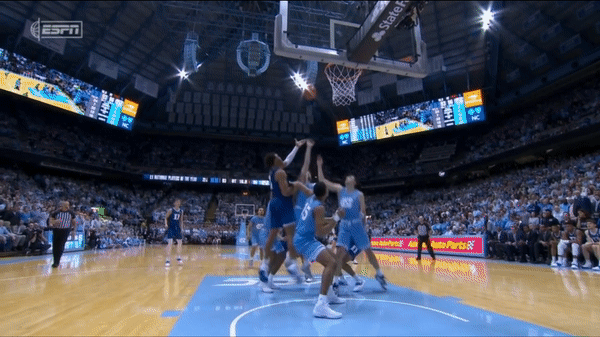
That, however, was not the closest call of overtime’s final minute.
Duke gets a call, Part II
Wendell Moore got to the rim with ease to complete a four-point possession and slash the lead to 1. The ensuing inbounds brought the most controversial play of the game. Moore met Platek and the ball near the Duke bench. A majority of neutral observers felt there should have been a foul called. I disagree. So did the refs.
10 seconds left, UNC up 1, no foul called here on the inbound. Duke gets ball and wins at buzzer #DUKEvsUNC pic.twitter.com/tJHt7ABayB
— Bad Sports Refs (@BadSportsRefs) February 9, 2020
Moore’s outstretched hand clearly dislodged the ball from Platek’s grasp. There also appeared to be shoulder to shoulder contact. But nothing flagrant. It’s not an egregious officiating mistake.
The double-whammy, though, was that the refs ruled that Platek had touched the ball last. Replays offered nothing close to convincing or conclusive either way. The call stood. Duke had the ball down 1 and, after all that, a chance to win.
Wendell Moore’s winner
Jones got fouled. He made the first to tie. Missed the would-be winner. But Moore, the only Duke player in rebounding position, tapped the rebound back toward midcourt. Five seconds later, he won the game. The video is above. This photo of his winning moment is golden:
Awesome photo from Bob Donnan/@usatodaysports of Wendell Moore’s Duke-UNC winner.
Tre Jones and Alex O’Connell celebrating before the ball even dropped through.
Agonizing/hilarious facial reactions through the Dean Dome crowd. pic.twitter.com/wA4vCvewlH— Henry Bushnell (@HenryBushnell) February 9, 2020
Moore didn’t know what to do. His teammates didn’t know which direction to run. Eight years to the day after Austin Rivers sunk Carolina, Moore was tackled on the same side of the same floor.
Austin Rivers.
Wendell Moore.
8 years to the day. 🔵😈 pic.twitter.com/wOo9EYYlBI— ACC Network (@accnetwork) February 9, 2020
The game had taken almost three hours. Unnecessary, lengthy reviews had prolonged it. The final 20.9 seconds took exactly 14 minutes and 30 seconds of actual time. On a normal night, fans would have moaned and groaned.
This was not a normal night. This was Duke-Carolina in all its glory. And it belongs among the rivalry’s greatest hits.
More from Yahoo Sports:


